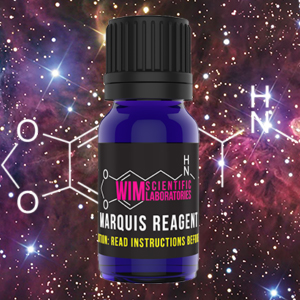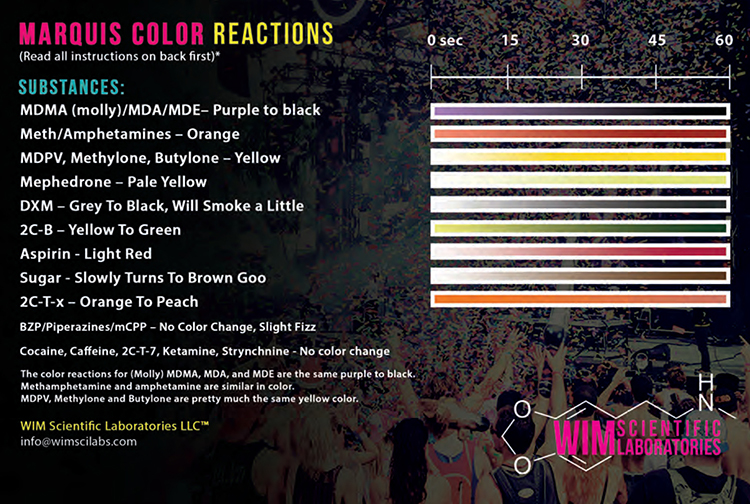Marquis Reagent Comprehensive Guide and Its Role in Harm Reduction
When it comes to identifying illicit substances, Marquis Reagent stands out as a pivotal tool. This reagent, a simple mixture of formaldehyde and concentrated sulfuric acid, allows for the presumptive identification of alkaloids and other compounds. The significance of this test reaches beyond mere curiosity—it’s a critical component in the strategy of harm reduction.
In this article, we’ll delve into the history, composition, and practical application of Marquis Reagent, emphasizing its role in mitigating drug-related risks.
Historical Background
The discovery of Marquis Reagent dates back to 1896, by the Russian pharmacologist Eduard Markus. Initially described in his magister dissertation, this reagent was first used at the University of Dorpat. Over the years, it has evolved from a laboratory experiment to a standard tool in forensic and safety testing, proving crucial in substance identification.
Composition and Chemistry
Marquis Reagent is a concoction of formaldehyde and sulfuric acid. When a drop of this reagent is added to a substance, it reacts chemically, changing color to indicate the presence of certain drugs. The exact color change depends on the substance it reacts with, providing a quick and reliable method to identify materials such as MDMA, opiates, and phenethylamines.
Uses in Substance Identification
The ability to test and identify substances accurately is where Marquis Reagent proves invaluable, especially in contexts like nightclubs and music festivals where MDMA, commonly known as ecstasy, is prevalent. Detailed instructions guide users to scrape off a tiny amount of the substance onto a testing surface, add a drop of Marquis Reagent, and observe the color reaction. Here’s a brief guide on the colors indicative of some common substances:
- MDMA shows a dark purple to black color.
- Heroin results in a deep purplish red.
- Aspirin presents a pink transitioning into deep red.
Importance in Harm Reduction
Harm reduction refers to policies, programs, and practices aimed at minimizing negative health, social, and legal impacts associated with drug use. By enabling the identification of substances, Marquis Reagent empowers individuals to make informed decisions, potentially averting the ingestion of harmful or undesired substances. For instance, the reagent can help users identify substances laced with fentanyl, which has been responsible for numerous overdose deaths.
Practical Guide on How to Use Marquis Reagent
To effectively use Marquis Reagent, one needs to follow a step-by-step procedure ensuring safety and accuracy in results. Here’s how to conduct a test:
- Prepare the sample: Scrape off a small amount of the substance to be tested onto a ceramic or glass surface.
- Add the reagent: Apply a drop of the Marquis Reagent to the sample using the dropper provided in the kit. Ensure that the reagent makes direct contact with the sample.
- Observe the reaction: Watch for a color change, which typically occurs within the first few seconds to one minute. Refer to a color chart provided with your kit to interpret the result.
- Safety first: Always wear protective gloves and possibly goggles while handling the reagent and samples. Work in a well-ventilated area to avoid inhalation of fumes.
Product Features and Specifications
High-quality Marquis Reagent kits, such as those offered by WIM Scientific Laboratories, include several essential components:
- 10ml of Marquis Reagent: Sealed in an ISO 9001 Quality Lab Material Certified Glass Dropper bottle to ensure safety and purity, capable of performing over 200 tests.
- Reaction vial and testing spoon: For safely placing and handling the sample.
- Detailed instruction manual: Including safe handling practices, storage instructions, and a digital reaction color chart for accurate interpretation of results.
The quality of the kit components is crucial as inferior products can lead to inaccurate results and potentially dangerous situations.
Purchasing and Handling
When purchasing a Marquis Reagent kit, it’s essential to select a reliable supplier. Avoid “copycat” chemist suppliers who often sell reagents stored improperly or made with contaminated materials. Here are some tips:
- Buy directly from accredited suppliers: This ensures you receive a fresh, accurately formulated reagent.
- Check the storage recommendations: Proper storage is critical for maintaining the reagent’s effectiveness. Typically, storing in a cool, dark place or in a freezer can significantly extend its shelf life.
- Understand the legal considerations: Be aware of the local laws regarding the possession and use of drug testing kits. In some jurisdictions, these materials may be regulated.
Ethical and Legal Considerations
While Marquis Reagent kits are a powerful tool for substance identification and harm reduction, they also come with ethical and legal responsibilities. Users should respect privacy and obtain consent if testing substances belonging to others. It’s also paramount to use this tool for safety and educational purposes, not for illicit activities.
By educating oneself about the proper use and potential implications of the Marquis Reagent, individuals and communities can significantly reduce the harms associated with unverified substance use, making environments like parties and festivals safer for everyone.


